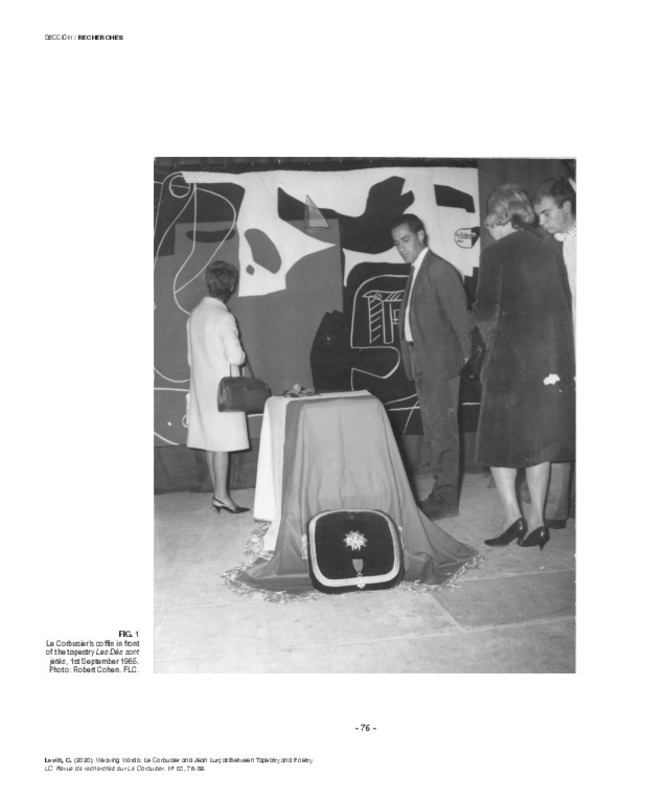JavaScript is disabled for your browser. Some features of this site may not work without it.
Buscar en RiuNet
Listar
Mi cuenta
Estadísticas
Ayuda RiuNet
Admin. UPV
Weaving Words: Le Corbusier and Jean Lurçat Between Tapestry and Poetry
Mostrar el registro sencillo del ítem
Ficheros en el ítem
| dc.contributor.author | Levitt, Caroline
|
es_ES |
| dc.date.accessioned | 2020-10-19T09:18:46Z | |
| dc.date.available | 2020-10-19T09:18:46Z | |
| dc.date.issued | 2020-10-07 | |
| dc.identifier.uri | http://hdl.handle.net/10251/152304 | |
| dc.description.abstract | [EN] Before his funeral service in the Cour Carrée of the Louvre on 1 September 1965, the body of Le Corbusier (1887-1965) lay with his tapestry Les Dés sont jetés (1960) as a backdrop. This article examines the place and significance of tapestry in Le Corbusier’s wider career as an architect, artist and poet, bringing out the ways in which his woven works of 1948 onwards are intricately connected to his thinking across media. Jean Lurçat (1892-1966), the protagonist of modern tapestry design, is usually sidelined in art historical analysis. In bring these two figures together, I find a point of encounter not only in their engagement with tapestry as a form of resistance and revolution via a medieval model, but also in their different uses of poetry in the broadest sense. Close readings of the imagery of the tapestries alongside the writings of the artists themselves, Paul Éluard and Stéphane Mallarmé reveal surprising connections. | es_ES |
| dc.description.abstract | [FR] L'article analyse l'usage que fait Le Corbusier de la photographie dans la publication et la diffusion de son oeuvre au cours des années 1920 et 1930, en prenant comme exemple paradigmatique de la Ville Church, Ville-d’Avray. Pour ce faire, nous proposons une lecture alternative à celle réalisée, de ce moyen, par Colomina (1988), en nous appuyant sur l'interprétation de la photographie surréaliste, effectuée par Rosalind Krauss (1981), comme signe et lecture. Concevant la photographie comme support matériel et lieu de dépôt de l'information - une sorte d’archive visuel prêt à être manipulé comme évidence documentaire, voire comme instrument autonome, dans la construction de nouveaux signifiants -, nous décrivons une stratégie dans l'édition des photographies qui se caractérise par son autonomie au regard du référent matériel ainsi que par sa manipulation moyennant les procédés partagés avec le Surréalisme. De ce point de vue critique, la photographie serait une technique ayant pour but de produire non pas des images mais des 'signes' dont la fonction est celle d'élargir et d'amplifier notre compréhension de la réalité et de l’architecture comme construction de cette dernière. | es_ES |
| dc.description.abstract | [ES] Antes de su funeral en el Cour Carrée del Louvre el 1 de septiembre de 1965, el cuerpo de Le Corbusier (1887-1965) yacía con su tapiz Les Dés sont jetés (1960) como telón de fondo. Este artículo examina el lugar y la importancia del tapiz en la carrera más amplia de Le Corbusier como arquitecto, artista y poeta, y resalta las formas en que sus obras tejidas de 1948 en adelante están intrincadamente conectadas a su pensamiento a través de los medios. Jean Lurçat (1892-1966), el protagonistga del diseño moderno de tapices, generalmente se deja de lado en el análisis histórico del arte. Al reunir estas dos figuras, encuentro un punto de encuentro no solo en su compromiso con el tapiz como una forma de resistencia y revolución a través de un modelo medieval, sino también en sus diferentes usos de la poesía en el sentido más amplio. Lecturas detalladas de las imágenes de los tapices junto con los escritos de los propios artistas, Paul Éluard y Stéphane Mallarmé revelan conexiones sorprendentes. | es_ES |
| dc.language | Inglés | es_ES |
| dc.publisher | Universitat Politècnica de València | es_ES |
| dc.relation.ispartof | LC. Revue de recherches sur Le Corbusier | es_ES |
| dc.rights | Reserva de todos los derechos | es_ES |
| dc.subject | Corbusier | es_ES |
| dc.subject | Jean Lurçat | es_ES |
| dc.subject | Tapiz | es_ES |
| dc.subject | Poesía | es_ES |
| dc.subject | Pierre Baudouin | es_ES |
| dc.subject | Le Corbusier | es_ES |
| dc.subject | Tapestry | es_ES |
| dc.subject | Poetry | es_ES |
| dc.subject | Tapisserie | es_ES |
| dc.subject | Poésie | es_ES |
| dc.title | Weaving Words: Le Corbusier and Jean Lurçat Between Tapestry and Poetry | es_ES |
| dc.type | Artículo | es_ES |
| dc.identifier.doi | 10.4995/lc.2020.13922 | |
| dc.rights.accessRights | Abierto | es_ES |
| dc.description.bibliographicCitation | Levitt, C. (2020). Weaving Words: Le Corbusier and Jean Lurçat Between Tapestry and Poetry. LC. Revue de recherches sur Le Corbusier. 1(2):76-89. https://doi.org/10.4995/lc.2020.13922 | es_ES |
| dc.description.accrualMethod | OJS | es_ES |
| dc.relation.publisherversion | https://doi.org/10.4995/lc.2020.13922 | es_ES |
| dc.description.upvformatpinicio | 76 | es_ES |
| dc.description.upvformatpfin | 89 | es_ES |
| dc.type.version | info:eu-repo/semantics/publishedVersion | es_ES |
| dc.description.volume | 1 | es_ES |
| dc.description.issue | 2 | es_ES |
| dc.identifier.eissn | 2660-7212 | |
| dc.relation.pasarela | OJS\13922 | es_ES |








